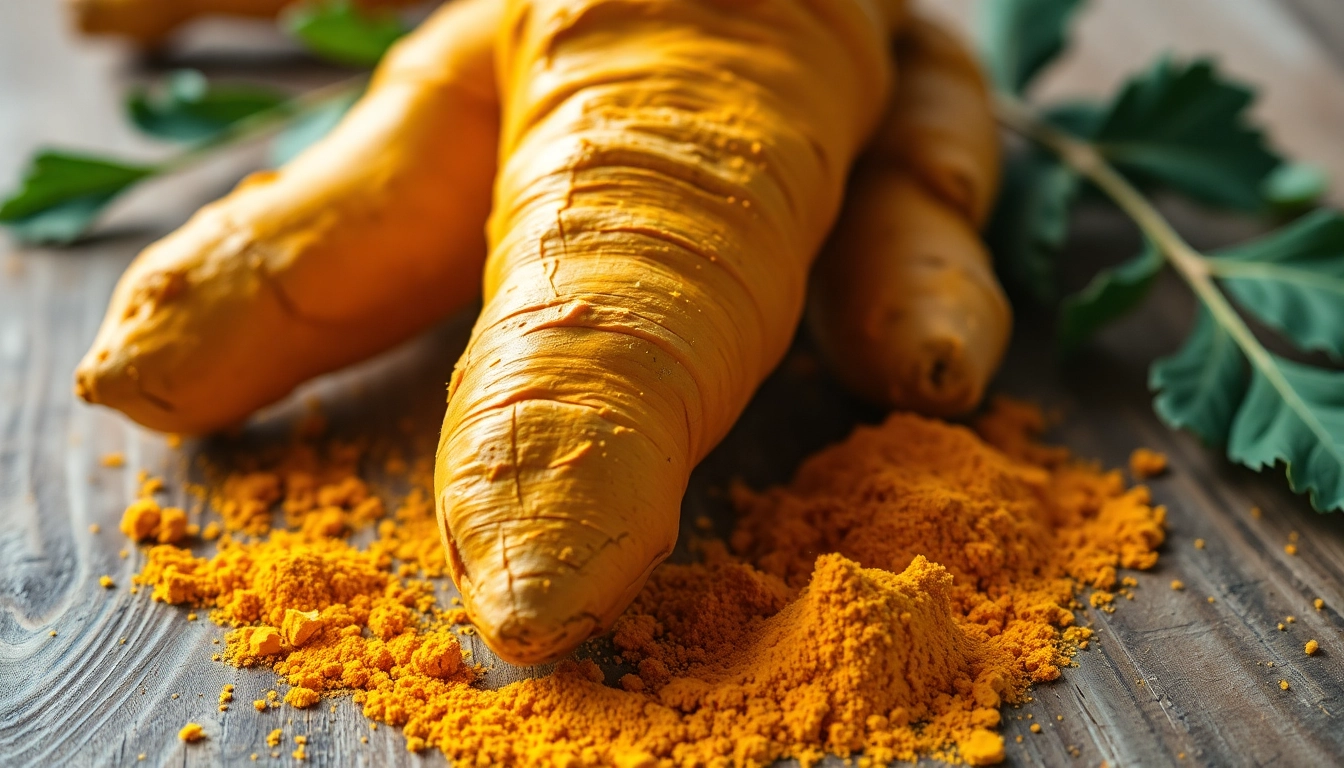Understanding Turmeric Root
What is Turmeric Root?
Turmeric root, scientifically known as Curcuma longa, is a flowering plant belonging to the ginger family. The rhizome, or root, of this plant is the part that is most commonly used for both culinary and medicinal purposes. Characterized by its vibrant yellow-orange color, turmeric root has gained immense popularity not only as a spice but also for its myriad health benefits.
Native to South Asia, turmeric has a long history in traditional medicine and cuisine. The root is typically harvested after several months of growth, boiled, and then dried before being ground into a fine powder. While turmeric powder is widely available, fresh turmeric root is prized for its potent flavor and nutritional profile. As an essential ingredient in many Asian dishes, it contributes a warm, earthy taste, making it a staple in curry and rice dishes around the world. You can explore more about this fascinating ingredient through resources like Turmeric Root.
Historical Significance in Medicine
The use of turmeric dates back over 4,000 years, primarily within Ayurvedic and traditional Chinese medicine. Historical texts highlight its application in treating a variety of conditions including inflammatory diseases, digestive issues, and skin ailments. Within Ayurvedic practices, turmeric is revered not just for its physical properties but also as a spiritual tool, signifying purity and prosperity.
Extensive research into turmeric’s medicinal effects—particularly focusing on its active compound, curcumin—has revealed its potential as a powerful anti-inflammatory and antioxidant agent. Modern studies continue to explore how curcumin and other compounds in turmeric can assist in managing chronic diseases and improving health outcomes.
Culinary Applications of Turmeric Root
Beyond its healing properties, turmeric root is a culinary darling. Its earthy flavor pairs well with various spices, enhancing both the taste and nutritional content of dishes. It’s most commonly recognized as an integral component of curry powders but has versatility that transcends regional cuisines. Here are several popular culinary applications:
- Curries: Turmeric is a key ingredient in curry dishes, providing a rich color and bold flavor.
- Golden Milk: This Ayurvedic drink combines turmeric, milk (or nut milk), and sweeteners, praised for its potential health benefits.
- Soups and Stews: Adding turmeric to these dishes not only boosts healthiness but also enriches the color and flavor profile.
- Teas: Fresh turmeric can be finely grated and steeped to create a soothing tea, infused with various spices such as ginger and cinnamon.
Health Benefits of Turmeric Root
Anti-Inflammatory Properties
One of the most well-documented health benefits of turmeric root is its powerful anti-inflammatory properties. Chronic inflammation is linked to numerous health issues, including arthritis, heart disease, and more. Curcumin, the active ingredient in turmeric, has been shown to inhibit various inflammatory pathways in the body.
Research indicates that consuming turmeric regularly can help reduce symptoms of these inflammatory diseases. For instance, one study found that curcumin supplementation reduced pain and improved functional ability in patients with osteoarthritis. Another trial revealed that participants taking curcumin experienced decreased inflammation markers compared to those on a placebo.
Antioxidant Effects
Turmeric root is rich in antioxidants, which play a crucial role in protecting the body from oxidative damage caused by free radicals. These free radicals can lead to cell damage and are associated with aging and various diseases, including cancer.
Curcumin not only neutralizes free radicals but also enhances the body’s own antioxidant defenses. Research has indicated that regular intake of turmeric root can significantly increase the levels of the body’s own antioxidant enzymes, thereby supporting overall health.
Potential Benefits for Digestive Health
Turmeric possesses several properties that may support digestive health. It is known to stimulate bile production, which aids in the digestion of fats. Additionally, its anti-inflammatory effects may help alleviate symptoms of inflammatory bowel diseases like Crohn’s disease and ulcerative colitis.
Many people have also found that turmeric can improve gut health by supporting beneficial gut bacteria. Studies have demonstrated that curcumin can enhance the growth of probiotics while inhibiting the growth of harmful bacteria, leading to a balanced gut microbiome.
How to Incorporate Turmeric Root into Your Diet
Using Fresh Turmeric Root
Fresh turmeric root is a versatile ingredient that can be easily added to various dishes. Here are some helpful tips on how to incorporate it into your diet:
- Peeling: Use a vegetable peeler to remove the skin before using fresh turmeric in your cooking.
- Grating: Grate fresh turmeric into soups, salads, or onto roasted vegetables for a zesty kick.
- Juicing: Add turmeric root into a juice blend with other fruits and vegetables for a nutrient-packed drink.
- Teas: Steep chunks of fresh turmeric in hot water to make a soothing and healing tea.
Recipes Featuring Turmeric Root
Incorporating turmeric into your cooking is not only beneficial but can also enhance the flavor of your meals. Here are a couple of simple recipes to get you started:
Turmeric Rice
Ingredients: 1 cup rice, 1 tablespoon fresh turmeric (grated), 2 cups vegetable broth, 1 onion (chopped), salt to taste.
Instructions:
- Sauté the chopped onion in a pot until translucent.
- Add the grated turmeric and rice, stirring for a minute.
- Pour in the vegetable broth and bring to a boil.
- Reduce heat to low, cover, and simmer for about 15-20 minutes, or until rice is tender.
- Fluff and serve warm.
Golden Milk Smoothie
Ingredients: 1 banana, 1 cup almond milk, 1 tablespoon fresh turmeric (grated), 1 tablespoon honey, pinch of black pepper.
Instructions:
- Place all ingredients in a blender and blend until smooth.
- Serve chilled as a refreshing breakfast or snack.
Storage and Preservation Tips
To maintain the freshness and potency of turmeric root, it’s essential to store it correctly. Here are some helpful storage tips:
- Keep fresh turmeric root refrigerated in a paper bag to absorb excess moisture and prolong freshness.
- For longer storage, dry the turmeric by slicing it into thin pieces and placing it in a dehydrator or an oven at low heat until fully dried.
- Store dried turmeric in an airtight container, away from light and heat, to maintain its flavor and health benefits.
Potential Side Effects and Precautions
Understanding Dosage
While turmeric root is generally safe for most people when consumed in culinary amounts, it can induce side effects if taken excessively. High doses of curcumin supplements can lead to gastrointestinal disturbances such as nausea and diarrhea. It is recommended to start with small amounts, gradually increasing as tolerated.
Some studies suggest that doses between 500 mg to 2000 mg per day can be beneficial for health while minimizing side effects. However, consulting with a healthcare provider for personalized guidance based on individual health status is always advisable.
Possible Allergies
Allergic reactions to turmeric are rare but can occur. Individuals with allergies to other members of the ginger family may be more prone to having an adverse reaction. Symptoms may include skin rashes, hives, or gastrointestinal upset. If you experience any of these symptoms after consuming turmeric, consult a medical professional promptly.
Interactions with Medications
Turmeric can interact with certain medications, such as blood thinners, anti-diabetic drugs, and medications that reduce acid in the stomach. It is crucial to speak with a healthcare professional before adding significant amounts of turmeric or curcumin supplements to your routine, especially if you are currently on medication.
Where to Buy Quality Turmeric Root
Finding Fresh Turmeric Root
Fresh turmeric root can typically be found in Asian grocery stores, health food stores, or specialty markets. When selecting fresh turmeric, look for firm roots with smooth skin and vibrant color. Avoid any roots that appear soft or have blemishes.
Choosing Quality Supplements
If you’re considering turmeric supplements, opt for high-quality brands that provide third-party testing to ensure purity and effectiveness. Look for products that contain standardized curcumin extracts, as they will deliver the concentrated benefits associated with turmeric’s active compounds.
Local Markets vs. Online Options
Local markets often provide the freshest options for turmeric root, as well as opportunities to speak with knowledgeable vendors about the product’s sourcing and quality. However, reputable online stores can offer convenience and a wider variety of turmeric products, including powders and capsules, for those unable to find fresh root nearby.



